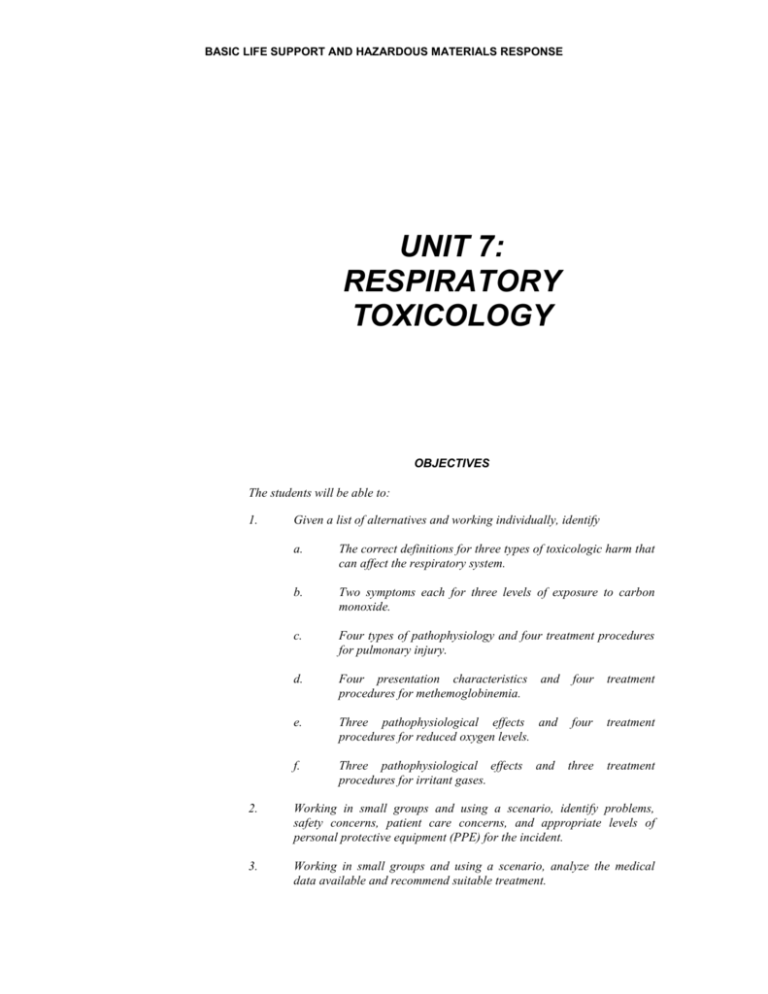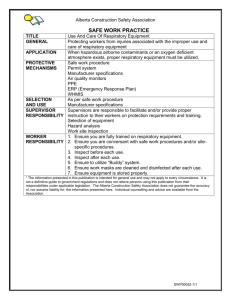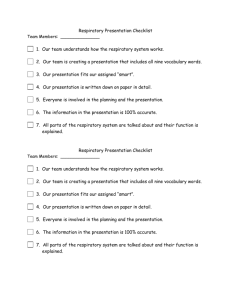UNIT 7 - LSU Fire and Emergency Training Institute
advertisement

BASIC LIFE SUPPORT AND HAZARDOUS MATERIALS RESPONSE UNIT 7: RESPIRATORY TOXICOLOGY OBJECTIVES The students will be able to: 1. Given a list of alternatives and working individually, identify a. The correct definitions for three types of toxicologic harm that can affect the respiratory system. b. Two symptoms each for three levels of exposure to carbon monoxide. c. Four types of pathophysiology and four treatment procedures for pulmonary injury. d. Four presentation characteristics procedures for methemoglobinemia. and four treatment e. Three pathophysiological effects and procedures for reduced oxygen levels. four treatment f. Three pathophysiological effects procedures for irritant gases. three treatment and 2. Working in small groups and using a scenario, identify problems, safety concerns, patient care concerns, and appropriate levels of personal protective equipment (PPE) for the incident. 3. Working in small groups and using a scenario, analyze the medical data available and recommend suitable treatment. RESPIRATORY TOXICOLOGY POINTS FOR THE INSTRUCTOR Many chemicals cause harm to the respiratory tract. Oxygen represents the most frequently successful treatment. Injury can be presented in a number of different ways. This unit requires students to read sections of their Student Manual, discuss key points with their group, add their own experiences and information to the Student Manual materials, and make a presentation to the class. ATTITUDES TO FOSTER Responders must protect themselves from respiratory injury while assessing and treating victims. METHODOLOGY This unit uses lecture, student readings and presentation, and a small group activity. (Total Time: 2 hr., 35 min.) 125 min. 30 min. Lecture Objectives Basic Concepts Small Group Activity 7.1 High School Incident HANDOUT Handout 7-1: Scenario IG 7-2 IG 7-3 IG 7-4 IG 7-15 RESPIRATORY TOXICOLOGY 125 min. Lecture I. OBJECTIVES (5 min.) The students will be able to: A. Given a list of alternatives and working individually, identify 1. The correct definitions for three types of toxicologic harm that can affect the respiratory system. 2. Two symptoms each for three levels of exposure to carbon monoxide. 3. Four types of pathophysiology and four treatment procedures for pulmonary injury. 4. Four presentation characteristics and four treatment procedures for methemoglobinemia. 5. Three pathophysiological effects and four treatment procedures for reduced oxygen levels. 6. Three pathophysiological effects and three treatment procedures for irritant gases. B. Working in small groups and using a scenario, identify problems, safety concerns, patient care concerns, and appropriate levels of personal protective equipment (PPE) for the incident. C. Working in small groups and using a scenario, analyze the medical data available and recommend suitable treatment. IG 7-3 RESPIRATORY TOXICOLOGY II. BASIC CONCEPTS (120 min.) Because of the technical nature of this material, this unit is presented in a self-study format. The class is divided into four groups to cover the materials. Each group summarizes the key points in its section and reports to the entire class. Prior to the small group work, the instructor covers the information in subsections A, B, C, and D of Section II Basic Concepts. A. The lungs are the only organ with vital functional elements in constant contact with the environment. B. Lungs have the largest exposed surface area of any organ. 1. The lungs have 70 to 100 square meters constantly in contact with external environment. 2. The skin is about two square meters. 3. The G.I. tract is about ten square meters. Stress for the students the guideline that there is no smoking, eating, or drinking at hazardous materials scenes. Emphasize that because of the respiratory system and the chance for internal contamination, there are compelling reasons why one should not smoke if contaminated or in a contaminated area. If a bit of humor is needed, make it a no smoking, eating, drinking, or flash photography rule. IG 7-4 RESPIRATORY TOXICOLOGY C. D. Respiratory tract is divided into three regions. 1. Nasopharyngeal section. 2. Tracheobronchial area. 3. Pulmonary acinus part. a. Respiratory bronchioles. b. Alveoli (about 100 million). Inhaled particles settle according to diameter. 1. 5 to 30 microns--nasopharyngeal. 2. One to five microns--tracheobronchial. 3. Less than one micron--alveoli. Assign the following sections to the groups. If you have more than four groups, the remaining one or two groups can cover the same materials as two of the other groups. This will assure a more comprehensive coverage. SM p. 7-9 SM p. 7-11 SM p. 7-11 SM p. 7-12 Easel Pad Group I: Group II: Group III: Group IV: Agents of Harm and Respiratory Injuries at Fire Scenes Other Fire Scene Concerns Asphyxiatin Injury Irritant Gases Each group summarizes three things for its section on an easel pad or newsprint: the pathophysiology; the symptoms; and the anticipated treatments. IG 7-5 RESPIRATORY TOXICOLOGY Each group then reports to the entire class. The following outline is for instructor use to verify that the presentations of the groups cover the essential information. After the groups have reported, touch on some of the key points in the outline below that you feel need to be stressed or clarified. Afterward, proceed to Activity 7.1. E. F. Many chemicals cause harm in the respiratory tract and are classified by type of harm. 1. Asphyxiants. 2. Irritants. 3. Necrotics. 4. Fibrotics. 5. Allergens. 6. Carcinogens. 7. No harm to lung, but systemic effects use the lungs as a pathway to bloodstream and other target organs. Respiratory injury at fire scenes. 1. 2. IG 7-6 Carbon monoxide is a product at most fires. a. Pyrolysis. b. Overhaul. Sources. a. Organic materials. b. Wood. RESPIRATORY TOXICOLOGY 3. c. Paper. d. Synthetics. e. Household furnishings. Pathophysiology. a. Carboxyhemoglobin. b. Decreased oxyhemoglobin. c. Hemoglobin preferentially binds with CO. d. Methemoglobinemia. - Oxyhemoglobin to methemoglobin. - Decreased oxygen delivery. - Increased tissue hypoxia. - Treatment. -- ABCs. -- Oxygenation. -- Decontamination. -- IV one-percent solution methylene blue one to two mg/kg; inject very slowly. 4. Mild exposure: 20 to 30 percent saturation. a. Headache. b. Nausea. c. Dizziness. d. Tachycardia. IG 7-7 RESPIRATORY TOXICOLOGY 5. 6. 7. IG 7-8 Moderate exposure: 30 to 50 percent. a. Syncope. b. Dyspnea. Severe exposure: over 50 percent. a. Seizures. b. Coma. c. Death. Other associated symptoms. a. Arrhythmias. b. Chest pain. c. Tachypnea. d. Slow, irregular respirations. e. Possible pulmonary edema from injury. f. Tinnitus. g. Hallucinations. h. Confusion. i. Visual disturbances. j. Impaired judgment. k. Loss of memory. l. Nausea, vomiting. m. Cyanosis, pallor, cherry red skin. 8. Pregnant patients at increased risk. 9. Exercise may speed symptomology. RESPIRATORY TOXICOLOGY 10. Expected dose response. a. 100 ppm, no symptoms. b. 200 ppm, mild headache. c. 800 ppm, unconsciousness after 2 hours. d. 6,400 ppm, headache; dizziness in 1 minute. e. 12,800 ppm, immediate unconsciousness; danger of death in 1 to 2 minutes. 11. Beware of delayed effects. 12. Uneventful convalescence from severe exposure may manifest up to three weeks later. 13. At one percent concentration of CO, firefighter may be too impaired to safely exit area. 14. Treatment. 15. a. ABCs. b. 100 percent oxygen (competitive inhibition reduces half life). c. Hyperbaric chamber. d. Be alert for cardiac complications. Carbon monoxide half-life. a. Room air four to six hours. b. 100 percent oxygen 60 to 90 minutes. c. Hyperbaric chamber 20 to 30 minutes. IG 7-9 RESPIRATORY TOXICOLOGY G. Pulmonary injury. 1. Flame. 2. Superheated gases. 3. Steam. 4. Corrosive effects of inhaled fire gases. 5. Pathophysiology. 6. 7. IG 7-10 a. Edema. b. Ciliary paralysis. c. Bronchospasm. d. Tissue sloughing. e. Acid formation. f. Surfactant loss. Presentation. a. Arrhythmias. b. Headache, dizziness, central nervous system depression. c. Coughing, rhinorrhea, burns to mucous surfaces, irritation of mucous surfaces. d. Shortness of breath, cyanosis, other signs of hypoxia. Treatment. a. Airway maintenance. b. Suctioning. c. Support of ventilations. RESPIRATORY TOXICOLOGY d. 8. 9. Oxygenation. Be alert for manifestations of poisoning from other products of combustion. a. Sulfur compounds. b. Hydrogen sulfide. c. Sulfur dioxide. d. Nitrogen compounds. e. Acid gases. f. Acetaldehyde. g. Acetic acid. h. Formaldehyde. i. Formic acid. j. Acrolein. k. Ammonia. l. Hydrogen cyanide. m. Phosgene. n. Hydrogen fluoride. Any significant exposure to smoke should be evaluated at E.D. a. Possibility of delayed onset. b. Chronic manifestations need documentation. Pulseoxymeters measure product saturation in the blood. Do not assume a high O2 saturation because the meter is reading high. The high reading may result from a toxic product such as CO which is saturating the red blood cells. IG 7-11 RESPIRATORY TOXICOLOGY H. Asphyxiation injury. 1. 2. 3. I. a. Combustion consumes oxygen. b. Slow oxidation occurs (confined space). c. Oxygen displacement occurs. Physiological effects of reduced oxygen. a. Twenty-one percent oxygen--none. b. Seventeen percent oxygen--slight impairment of coordination, increased respiratory rate. c. Twelve percent oxygen--dizziness, headache, rapid fatigue. d. Nine percent oxygen-unconsciousness. e. Six percent oxygen--death within minutes. Treatment. a. Oxygenation. b. Ventilatory support. c. Airway management. d. ALS as indicated, seizure control, etc. Irritant gases. 1. IG 7-12 Oxygen-deficient atmosphere may result under certain conditions. Ubiquitous. a. Chlorine. b. Ammonia. RESPIRATORY TOXICOLOGY 2. 3. 4. c. Sulfur dioxide. d. Phosgene. e. Oxides of nitrogen. Pathophysiology. a. Highly soluble--chlorine, ammonia, sulfur dioxide. b. Severe respiratory irritation. c. Hydrochloric acid in lungs. d. Fluid build-up. e. Skin, eye irritation. f. May be self-limiting. Presentation. a. Ventricular arrhythmias, cardiovascular collapse. b. Noncardiogenic pulmonary edema, dyspnea, tachypnea, cough, rhinorrhea. c. Headache, dizziness, central nervous system depression, coma. d. Nausea, vomiting. e. Lacrimation, burn to eyes. f. Chemical burns to skin. g. May be delayed, olfactory fatigue. h. Stridor. Treatment. a. Airway, ventilatory support. IG 7-13 RESPIRATORY TOXICOLOGY b. Irrigation of eyes. c. Bronchodilators. Introduction to the High School Scenario With this unit begins a four-part scenario consisting of an escalating incident at a local high school. While each scenario part presents a limited amount of information, the intent is to not limit you or the students in the management of the unfolding incident. However, you must exercise care to keep the activities focused on the desired outcomes and recommended answers. You will find additional background information in this Instructor Guide for each part of the scenario. Do not divulge this additional information unless students ask for it. Part of the dynamic of this series of activities is to see if the students can make proper decisions on the information they receive or if they need more information to make better informed decisions. Once you have revealed all the additional background information, you need to answer further questions with the response, "We do not have any further information." Do not make up additional information. This could compromise the benefit of the activity. The responses throughout the four parts are predicated on hazardous materials training to the Awareness Level. It is important to guide the class through the stages of the scenario. The aim is to have the students deal with each level but, as the next part of the scenario is introduced, have them move on to consider the new information and its implications. The students do not have the scenario information in their manuals. They do, however, have the worksheets. Therefore, you need to make enough copies of the scenarios so that each student receives a copy. Distribute the scenario (handout) at the start of each activity. IG 7-14 RESPIRATORY TOXICOLOGY 30 min. Small Group Activity 7.1 Activity 7.1 High School Incident Purpose To identify the real concerns, problems, and response associated with a simulated incident in a high school. Directions to Students SM p. 7-3 1. The students will work in small groups. 2. Distribute Handout 7-1. 3. Clarify the information as needed and then have the students answer the questions on the worksheet. 4. After no more than 10 minutes, solicit answers for the questions. 5. Go from group to group until all questions have been answered. Avoid repetition. 6. Keep the discussion focused on current actions and future possibilities. 7. The suggested responses can be found on the following Student Activity Worksheet. Handout 7-1 IG p. 7-17 Summary Summarize briefly by pointing out that this is the first step in the thoughtful process of analysis and decisionmaking required at hazardous materials incidents. IG 7-15 RESPIRATORY TOXICOLOGY Provide this additional information only if asked. Smithville High is a medium-size high school of about 825 students. It is a Thursday in late May. The day is bright and warm. The temperature is already 70°F. The relative humidity is 40 percent. There is a light, variable wind from the south. The two persons the first responders find in the nurse's office had just spent 15 minutes in the Teachers' Lounge. They were alone. IG 7-16 RESPIRATORY TOXICOLOGY STUDENT ACTIVITY WORKSHEET Activity 7.1 High School Incident Purpose To identify the real concerns, problems, and response associated with a simulated incident in a high school. Directions 1. Work in small groups. 2. Using the scenario information provided in Handout 7-1 and referring to the floor plan of the high school on the next page, answer the questions on the Worksheet. 3. You will have no more than 10 minutes. Suggested responses: High flow of oxygen via a nonrebreather mask Place the patients in positions of comfort Transport to an appropriate medical facility IG 7-17 RESPIRATORY TOXICOLOGY IG 7-18 RESPIRATORY TOXICOLOGY STUDENT ACTIVITY WORKSHEET Activity 7.1 (cont'd) Floor Plan Exit Exit Office Office Nurse's Office Chemistry Lab Biology Lab Teachers' Lounge Girls' Restroom Boys' Restroom Exit Auto Mechanic Shop Overhead Door IG 7-19 RESPIRATORY TOXICOLOGY IG 7-20 RESPIRATORY TOXICOLOGY STUDENT ACTIVITY WORKSHEET Activity 7.1 (cont'd) Worksheet What problems do you see? What safety concerns do you have for the emergency medical responders? What are your patient care concerns? What are the symptoms? How long have the victims been displaying the symptoms? IG 7-21 RESPIRATORY TOXICOLOGY STUDENT ACTIVITY WORKSHEET Where were the victims prior to arriving at the nurse's station? How long had they been at the previous location? Was anything unusual there? To what does it appear they have been exposed? What would seem to be an acceptable treatment? What is the appropriate level of hazardous materials response? IG 7-22 RESPIRATORY TOXICOLOGY IG 7-23





